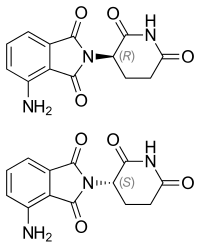Pomalidomide
 |
|
| Clinical data | |
|---|---|
| Trade names | Pomalyst, Imnovid |
| AHFS/Drugs.com | Monograph |
| License data |
|
| Pregnancy category |
|
| Routes of administration |
Oral (capsules) |
| ATC code | |
| Legal status | |
| Legal status | |
| Pharmacokinetic data | |
| Bioavailability | 73% (at least) |
| Protein binding | 12–44% |
| Metabolism | Liver (mostly CYP1A2- and CYP3A4-mediated; some minor contributions by CYP2C19 and CYP2D6) |
| Biological half-life | 7.5 hours |
| Excretion | Urine (73%), faeces (15%) |
| Identifiers | |
|
|
| CAS Number | |
| PubChem CID | |
| IUPHAR/BPS | |
| ChemSpider | |
| UNII | |
| KEGG | |
| ChEMBL | |
| ECHA InfoCard | 100.232.884 |
| Chemical and physical data | |
| Formula | C13H11N3O4 |
| Molar mass | 273.24 g/mol |
| 3D model (Jmol) | |
| Chirality | Racemic mixture |
|
|
|
|
|
|
|
Pomalidomide (INN, codenamed CC-4047, also known as 3-amino-thalidomide, trade name Pomalyst in the U.S. and Imnovid in EU and Russia) is a derivative of thalidomide marketed by Celgene. It is anti-angiogenic and also acts as an immunomodulator.
Pomalidomide was approved in February 2013 by the U.S. Food and Drug Administration (FDA) as a treatment for relapsed and refractory multiple myeloma. It has been approved for use in people who have received at least two prior therapies including lenalidomide and bortezomib and have demonstrated disease progression on or within 60 days of completion of the last therapy. It received a similar approval from the European Commission in August 2013.
The parent compound of pomalidomide, thalidomide, was originally discovered to inhibit angiogenesis in 1994. Based upon this discovery, thalidomide was taken into clinical trials for cancer, leading to its ultimate FDA approval for multiple myeloma. Structure-activity studies revealed that amino substituted thalidomide had improved antitumor activity, which was due to its ability to directly inhibit both the tumor cell and vascular compartments of myeloma cancers. This dual activity of pomalidomide makes it more efficacious than thalidomide in vitro and in vivo.
Phase I trial results showed tolerable side effects.
Phase II clinical trials for multiple myeloma and myelofibrosis reported 'promising results'.
Phase III results showed significant extension of progression-free survival, and overall survival (median 11.9 months vs. 7.8 months; p = 0.0002) in patients taking pomalidomide and dexamethasone vs. dexamethasone alone.
...
Wikipedia
